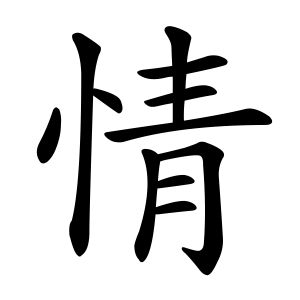情
- feeling;
- emotion;
- sentiment;
Etymology
Usage in Korean
It appears in many common words:
감정 (感情) – emotion;
정의 (情誼) – affection, bond;
동정 (同情) – sympathy.
Words that derived from 情
- 국정(國情)–state of affairs in a country
- 부정(父情)–paternal love
- 순정(純情)–pure love
- 심정(心情)–shimjeong; feeling; thought; temper
- 애정(愛情)–love; affection
- 열정(熱情)–passion
- 우정(友情)–friendship
- 정(情)–bond; feeling: A state of mind that forms when one feels something
- 정보(情報)–information; data
- 정보화(情報化)–digitization
- 정분(情分)–affection; love
- 정상(情狀)–circumstances; pitiful state
- 정의(情誼)–friendship; bond
- 진정(眞情)–truth; sincerity; true reasons
Additional notes
情 is an extremely familiar hanja in Korea — even appearing on the packaging of Orion Choco Pie (초코파이 情), where it conveys warmth, affection, and caring emotion.
Alternative forms
In mainland China, Hong Kong (based on its educational standard), Japanese kanji and Vietnamese Hán Nôm, the bottom right component is written ⺝ with a vertical 丨 left stroke.
In Taiwan, the bottom right component is written 月 with a curved 丿 left stroke.
In Korean hanja, the bottom right component is written 円 which is the historical form found in the Kangxi Dictionary.
情
뜻
정
tteut
jeong
Kangxi radical:61, 心 + 8
Strokes:11
Unicode:U+60C5
Cangjie input:
- 心手一月 (PQMB)
Composition:
- ⿰ 忄 青 (G H T J V)
